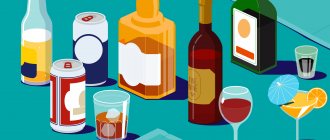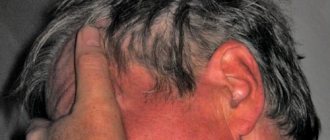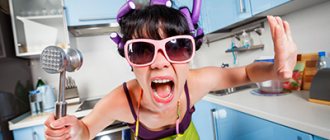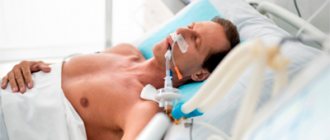With autonomic dysfunction, a variety of symptoms appear that do not fit into the overall picture of any known disease. With VSD, organic damage to other organs is usually not found, and the patient’s attempts to find a terrible disease in himself are futile and do not bear the expected fruit.
In our clinic we use the most effective method of treating vegetative-vascular dystonia at the moment according to the results of a study at the St. Petersburg Research Psychoneurological Institute named after Bekhterev - this is solar micropolarization, in combination with drug treatment, where the main attention is focused on eliminating concomitant diseases, viral or chronic nature.
Reasons for the appearance of neurosis against the background of VSD
In essence, neurosis is a state of exhaustion of the nervous system, which occurs during prolonged and intense stressful situations, unresolved internal conflicts and is manifested by a variety of physical and mental symptoms.
Among the physical ones there are:
cardiac or headaches;- feeling of weakness, fatigue;
- dizziness, darkening of the eyes;
- sleep disturbance (difficulty falling asleep, shallow sleep, frequent awakenings, feeling tired in the morning);
- GCT disorders (poor appetite, abdominal pain, dysfunction of the intestines and stomach);
- autonomic disorders (excessive sweating, pressure changes, feeling of irregular heartbeat).
Psychiatric include:
- hypochondriacal syndrome;
- increased anxiety, attacks of panic and fear;
- mood variability;
- communication problems;
- irritability, nervousness;
- high sensitivity to external stimuli: light, sounds, smells;
- low stress resistance.
The clinical signs of VSD are almost the same, however, in dystonia, somatic disorders predominate. The causes of these diseases largely coincide:
- prolonged emotional or physical stress;
- lack of sleep;
- bad habits;
- chronic diseases;
- poor nutrition;
- traumatic brain injuries;
- changes in hormonal levels;
- osteochondrosis of the cervical vertebrae.
It is easy to see that both the causes and main symptoms of VSD and neurosis are very similar. Doctors often confuse these conditions, or both diseases are present in one patient.
Symptoms of anxiety neurosis
The clinical manifestation of the disease is characterized by the following symptoms of a mental, somatic and vegetative nature:
- causeless anxiety of varying intensity: from a state that the patient describes as “anxious in the soul” to a paroxysmal feeling of an impending catastrophe;
- persistent intrusive thoughts of disturbing content with detailed thinking about dialogues or actions in response to various imaginary events;
- anxiety or fear over the most insignificant reasons;
- increased irritability;
- panic attacks during exacerbation;
- the occurrence of concomitant mental disorders during a long chronic period of the disease - hypochondria, depression, obsessive-compulsive neurosis;
- vegetative-vascular hyperactivity, which can be expressed in pain in the heart, rapid heartbeat, respiratory distress (feeling of lack of air), discomfort in the epigastric region (between the navel and sternum), dry mouth, increased sweating;
- sleep disorders - insomnia, interrupted sleep, disturbing dreams, nightmares;
- muscle hypertonicity, inability to relax, fussiness, tension headaches, trembling due to impaired motor functions;
- feeling of constant fatigue, lightheadedness, dizziness, loss of orientation;
- nausea, stool disorder (IBS - irritable bowel syndrome), appetite.
The main symptom of generalized anxiety disorder is the patient’s inability to clearly identify the cause or object of a long-lasting (from several weeks to several months) state of fear and anxiety.
Treatment
First of all, if characteristic symptoms appear, you need to consult a doctor to undergo all examinations and establish an accurate diagnosis. This is very important, since dangerous diseases such as coronary heart disease or depression can be hidden under the guise of vegetative-vascular dystonia or neurosis.
Both neurosis and VSD require almost the same treatment. In this case, an integrated approach is used using medications, psychotherapy, physical therapy, and physiotherapeutic methods. It is also very important to follow preventive recommendations that have a greater impact on the causes of the disease.
Of course, first of all it is necessary to restore the patient’s psyche, because this is precisely the main reason. The doctor must identify factors, including hidden ones, that contributed to the development of the disease, and help the patient fight them, teach him to control stress. Modern medicine uses the approaches of psychoanalysis and cognitive behavioral psychotherapy. Meditation and auto-training are considered very effective preventive methods.
To relieve unpleasant symptoms, drug treatment is used. The following groups of drugs are used:
- antidepressants;
- sedatives;
- beta blockers;
- vitamins.
Physiotherapy has a complex effect on the body, is well tolerated by patients and has almost no contraindications. Its main methods include:
- acupuncture;
- electrophoresis;
- massage;
- water procedures.
Traditional drug treatment
It is necessary to take into account that there is no unambiguous group of funds for VSD. Doctors are guided by the situation that each patient demonstrates. Depending on different conditions, different courses of medications may be recommended.
But, in the vast majority of cases, it includes Corvalol, a group of antidepressants, tranquilizers. They are used to achieve a sedative effect. Taking them improves mood, reduces stress, irritation and insomnia. In addition, due to the fact that when taking sedatives, the effect of muscle relaxation is achieved, the manifestation of pain becomes less pronounced.
But, it is necessary to pay attention to the possibility of harmful effects and side effects. Naturally, in a healthy body, the use of drugs from these groups is unlikely to cause a mixed negative effect. But, in a difficult situation, for example, when the patient is pregnant, or the patient is a child, it is necessary to avoid the effects of certain components on the body. Therefore, basically, doctors in such cases help their patients by prescribing herbal teas or herbal preparations.
Plants such as hawthorn, motherwort or other substances help. If you take them periodically, then between courses you must take a certain pause, which will be indicated by your doctor. A pause should be mandatory, since plants are the same medicines as drugs from the pharmacy. The regimen of use must either be prescribed by a doctor, or the patient uses the source of information indicated on the package.
Use of vitamin complexes
The name itself (translated as “amines of life”) speaks of the importance of these substances in the functioning of the body. With any disease, the consumption of vitamins increases significantly, while their intake from food may decrease (for example, due to impaired appetite). Therefore, most doctors prescribe appropriate medications to compensate for the deficiency that arises from VSD and neurosis:
- Vitrum;
- Supradin;
- Pikovit.
However, it is much better to use natural forms, in the form of fresh fruits and vegetables. Another danger is an overdose of vitamins, which is just as dangerous as their absence. Therefore, do not try to treat yourself; be sure to consult a doctor.
For the treatment of VSD and neuroses, the following vitamins are necessary:
- B1 (Thiamin) – found in bread, liver, beef, black currant;
- B3 (Niacin) – meat and dairy products, cereals;
- B6 (Pyridoxine) – carrots, nuts, potatoes, liver;
- B12 (Cyancobalamin) – beef, seafood, greens;
- PP (nicotinic acid) – apples, cherries, grapes;
- C (ascorbic acid) – citrus fruits, currants, cabbage, beets.
Causes of VSD
The causes of vegetative-vascular syndrome in people of different ages can differ radically. Most often this occurs due to central nervous system disorders and infectious diseases. A lot of stress and poor nutrition can also lead to disruption of the body's functionality. The immune system ceases to resist infections and the person becomes ill. Another reason may be lack of mobility and sedentary work habits. Due to lack of physical activity, excess weight appears, and this leads to diseases of the heart and musculoskeletal system.
Other causes of VSD:
- hormonal imbalances in older women, pregnant women and teenagers;
- diabetes;
- bad habits such as smoking, alcohol, etc.
- chronic diseases (ulcers, asthma);
- emotional and physical fatigue;
- stress due to changes in usual living conditions;
- head and spine injuries;
- heredity;
- birth trauma and hypoxia (in newborns).
The effectiveness of gymnastics and exercise therapy
The effect of therapeutic exercises for VSD and neuroses is very great. During physical activity, “happiness hormones” are produced: endorphin and serotonin. This helps fight stress and neurasthenia well. In addition, exercise therapy strengthens general tone, immunity, improves blood circulation, which has a positive effect on the patient’s condition, especially in the hypotonic form.
A very good method that perfectly treats VSD and neurosis is breathing exercises that can train the autonomic nervous system and improve blood supply to the brain. They have a calming effect and help cope with panic attacks that often occur with VSD.
Exercise therapy classes should be strictly supervised by a doctor, because this is the only way they can bring benefit and not harm. It is recommended to leave professional sports for some time, which usually require significant stress that is incompatible with such a disease.
Diagnostics
Patients with signs of VSD need consultation with a neurologist, cardiologist, endocrinologist, and in some cases, a psychotherapist. Doctors carefully question the patient about the nature of the complaints and prescribe the necessary tests: electroencephalography EEG, functional tests to analyze the activity of the autonomic nervous system, an ECG is required.
Our clinic presents a unique diagnostic system that includes a comprehensive study of the autonomic nervous system with simultaneous study of heart and respiratory rhythms. Diagnosis of neuropathy using cardiovascular tests recommended by the San Antonio conference (1998)
Headache and how to deal with it during VSD
The results of research by scientists have shown that men are less likely to suffer from headaches with VSD; accordingly, this is the fate of women to a greater extent. This problem haunts them throughout the day from the moment they wake up until they go to bed (during sleep, the headache usually does not bother them). A woman constantly has to say “no” to the most pleasant and joyful moments in her life. Here is a simple example, about which so many anecdotes and jokes have already been written, a woman increasingly begins to avoid marital responsibilities, citing an illness that is debilitating her. Even close people sometimes do not understand her torment, considering her just a good actress and a liar. But this is not the case, and it’s worth looking into.
Causes of pain
We also know from the school biology curriculum that the cause of this disease is the narrowing or dilation of blood vessels in the human brain. Everything is true, but not in the case of people suffering from VSD.
Of course, first of all, it is necessary to undergo a full examination in order to certainly exclude abnormalities in the functioning of the blood flow to the brain. Today, there are many methods that will identify diseases, if any, with 100% accuracy. For example: MRI, CT, REG, EEG and ultrasound.
If studies have not revealed obvious causes, then the main source of pain can be considered a disease caused by a disorder of the central nervous system, in other words, neurosis. Thus, headache cannot be considered as an independent disease, because it is a consequence of a disorder of the nervous systems as a whole.
How to distinguish a headache with VSD from any other
- In the case of VSD, the pain is usually continuous.
- Its intensity is the same, that is, not sharp, not fading and “not shooting.”
- When you sleep, the pain usually does not bother you.
- The localization of pain can be varied; the whole head or a separate part of it can hurt. For example, the right or left half of the brain, as in hemicrania, better known to us as migraine.
- Very often there is a feeling of swelling and some kind of strange pressure in the frontal area, around the eyes and temples.
- Most importantly, head pain with VSD does not depend on blood pressure, and it cannot be relieved with symptomatic medications.
treatment of headaches in people suffering from VSD
As we have already said, the pain in the head with VSD is constant and, unfortunately, no medicine in our medicine cabinet can often curb it: not analgin, not citramon, not no-spa, etc. Some painkillers can only reduce its intensity for a short time, but cannot completely get rid of it. In this case, sedatives that cause calm or reduce emotional stress, as well as tranquilizers, come to the rescue. Among sedatives, the most popular are herbal preparations such as valerian, motherwort and mint.
Remember, a headache in the case of VSD is only one of the signs of a disorder of the nervous system. Therefore, it is necessary to treat the entire body, not just the head or another part of the body. Today, many believe that the main cause of constant headaches is osteochondrosis. They spend a huge amount of money and time on its treatment, but there is no result, the pain does not go away. The main rule that a patient suffering from VSD must learn: osteochondrosis of the cervical spine is in no way connected with the development of VSD, and, accordingly, with pain in the head.
In order to help yourself with headaches, you first need complex treatment of vegetative-vascular dystonia. And you should start by taking medications that will relieve feelings of anxiety, fear and panic (we wrote about them just above).
Well, in general, giving up bad habits, a healthy balanced diet, a positive attitude towards life, a proper work and rest schedule, moderate physical activity and just walks in the fresh air will help you avoid headaches.
Author: K.M.N., Academician of the Russian Academy of Medical Sciences M.A. Bobyr









